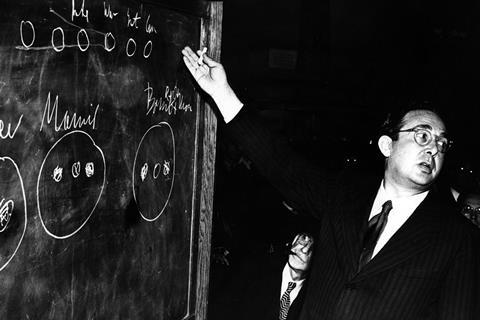How Leo Szilard’s concept emerged from a rich interchange of ideas across disciplinary silos
Richard Rhodes’ magisterial The Making of the Atomic Bomb (1986) begins very memorably. As he steps off the kerb to cross the road in central London on a dreary autumn morning in 1933, Hungarian physicist Leo Szilard, a refugee from Nazi Germany, has a vision. He realises how it might be possible for radioactive decay of a nucleus to initiate a chain reaction so as to ‘liberate energy on an industrial scale, and construct atomic bombs’. In that moment, Rhodes writes, ‘time cracked open before him and he saw a way to the future, death into the world and all our woe, the shape of things to come.’
That last phrase alludes to H G Wells’ famous novel, published just two weeks earlier. Wells was among Szilard’s acquaintances in England, and in 1932 Szilard read his earlier The World Set Free (1914), in which Wells imagined the immense energy recently discovered to be locked inside the nucleus being harnessed to make bombs of apocalyptic power.

Szilard’s prescience was world-changing. In 1938, Otto Hahn and Fritz Strassmann at the Kaiser Wilhelm Institute for Chemistry in Berlin discovered nuclear fission of uranium. Once their results had been correctly interpreted by physicist Lise Meitner, formerly Hahn’s colleague but by late 1938 exiled in Sweden as an Austrian Jew, Szilard realised that atomic bombs were now feasible, and he drafted with Albert Einstein the letter to US president Franklin D Roosevelt that initiated the Manhattan Project.
But the nuclear chain reaction was not in itself the Hungarian physicist’s idea. The basic phenomenon is outlined clearly in the 1923 book by Hendrik Kramers, The Atom and the Bohr Theory of Its Structure. Imagine, Kramers asked, what would happen ‘if it were possible to bring about artificially a transformation of elements [by nuclear decay] propagating itself from atom to atom with the liberation of energy … There is then offered the possibility of explosions more extensive and violent than any which the mind can now conceive.’
Kramers might be familiar to some readers from the Christiansen–Kramers theory of the kinetics of unimolecular reactions. The Dutch physicist went to Copenhagen in 1916 to study with Niels Bohr before becoming Bohr’s assistant until 1926. While he was thus a part of the team of young scientists around Bohr who worked to establish quantum theory, he also took a strong interest in chemical kinetics. When the Danish chemist Jens Christiansen, formerly an assistant to Sophus Sørensen of pH fame, came as a guest to Bohr’s new Copenhagen institute in 1922–23, he and Kramers collaborated in the study of unimolecular reactions in which the energy of the products was passed on to other reactant molecules, creating what they called a Kettenreaktion: a chain reaction.
Another link
Christiansen had already used the term (koedereaktion in Danish) in his 1921 doctoral dissertation, for which Bohr was an examiner. As historian of science Helge Kragh of the Niels Bohr Institute points out,1 the phrase wasn’t new even then, having been used in biology in 1907 by the German–American embryologist Jacques Loeb – a curious foreshadowing of the way ‘fission’ was borrowed from biology for the splitting of the uranium atom. Kragh points out that the concept, if not the term, was also adduced in 1913 by the German physical chemist Max Bodenstein to describe photochemical reactions that involve the emission of secondary photons – itself an idea stemming from Einstein’s studies of photochemistry. Christiansen cited Bodenstein’s work in his 1921 thesis.
Given all this overlap between chemical kinetics and fundamental work in quantum and nuclear physics, it’s not surprising that Kramers saw in 1923 how propagating nuclear decay would mimic a chemical chain reaction. By the early 1930s the concept was well established in chemistry – as Szilard knew. What changed in 1933 was that he could see a concrete mechanism for it in nuclear reactions. The previous year, James Chadwick at the Cavendish Laboratory in Cambridge had discovered the neutron as a component of the atomic nucleus. Being electrically neutral, it was clear that the neutron might penetrate the positive nucleus more easily and induce a decay that released nuclear energy. Szilard saw that if such decays themselves generated more neutrons, the decay could propagate in just the way Kramers had described.
Could all this happen in today’s era of siloed disciplines?
Knowing that the term existed in chemistry, Szilard sought out Chaim Weizmann, the chemist at Manchester who Bohr had befriended while he worked there under Rutherford to develop his quantum theory of the atom. Szilard also spoke about the idea with his compatriot, physical chemist Michael Polanyi, another refugee from the Nazis at Manchester.
Could all this happen in today’s era of siloed disciplines? It’s hard to imagine – but maybe too the story reflects the way quantum and nuclear science then sat at the border of physics and chemistry at a unique moment in the history of science.
Editor’s note: This article was updated on 22 July 2024 to say that it was Michael Polanyi and not his son John who corresponded with Szilard
References
1 H Kragh, Bull. Hist. Chem., 2024, 49, 62

















No comments yet